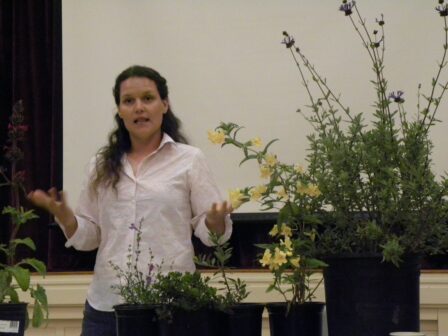
Amy Huie showed us a selection of several varieties of natives which she had chosen from Mission Hills Nursery.
In May, Amy Huie spoke to the Mission Hills Garden Club about native plants. Before beginning her talk, she thanked the Mission Hills Garden Club. As she put it, “My first horticultural job was financed by Mission Hills Garden Club.” She was a student at Cuyamaca College, and Fausto Palafox, owner of Mission Hills Nursery, was one of her teachers.
Although her topic was California Natives, she hastened to assure us that natives can co-exist nicely within your established garden. The important criteria are to keep plants with similar needs together, to place them where they will show to their best advantage, and to utilize color, shape, texture and size in creating a design. If the plants don’t have the same requirements, no matter what you do, some will perish.
Huie showed us a selection of several varieties of natives which she had chosen from Fausto’s nursery. Cleveland Sage was the first plant she showed us. Due to its pungent scent, it is best to plant it at a distance from your home or outdoor entertaining area. I must admit that its smell is what I imagine a cross between bad body odor and cheap perfume would be. In the seat beside me, Teri Skwarlo whispered she was ready to move; and until Huie mentioned its “peculiar” scent, I honestly thought someone sitting near us was the culprit and was ready to move with her! Despite its unpleasant odor, it comes in a variety of shapes and sizes and its beauty belies its other characteristic. The “Winifred Gilman” variety of Cleveland sage provides shelter for ground dwelling birds like Towhees, Mourning Doves and White-crowned Sparrows.
Hummingbirds love tubular blooms such as penstemon and monkey flower. They are a perfect fit for the hummingbird’s long and slender beak.
Unlike hummingbirds, butterflies prefer flat blossoms on which they can perch. They love sage and will even go to varieties that thrive in shade. The monarch butterfly loves and breeds in milkweed. Since milkweed is not particularly pretty, it can be planted behind a more comely plant, giving you both beauty and butterflies. Milkweed also attracts bees and wasps. Huie says that while it “gets covered in aphids,” ladybugs will soon come to dine on the aphids. Huie likes milkweed for teaching children “about the interdependence of life.”
Some natives add color, texture, shape, or all three to your garden. Redberry, as its name suggests, has red berries which add color and interest to the garden. Another California native, the manzanita, also adds color; its beautiful bark is a reddish brown. The dark mahogany-colored branches add wonderful interest to flower arrangements. It can have a practical use in your garden as well. One variety of manzanita, Emerald Carpet is a good ground cover. Other varieties come in tree form as well. Manzanita is one of Huie’s and my favorites.
Another frequently used as foliage for floral designs is coffee berry. Fairly easy to grow, these plants have pretty brown berries attracting birds to their branches. In arrangements they are long-lived.
Buckwheat can also add beauty to the garden. Both red and yellow (Conejo) buckwheat stay small, with vividly colored flowers and greyish foliage. Bees love it. You can find larger varieties of buckwheat if you prefer it.
A native which curbs homesickness in the humans transplanted from colder climates is the California Lilac. The blooms resemble lilacs from these people’s pasts. California lilacs can be found as a groundcover, a bush, or a tree. Sadly, I managed to kill the one I planted.
Huie reminded us that not all natives are drought tolerant. We have marshlands and riverbeds where water loving natives grow. Because our climate here in Southern California varies greatly from neighborhood to neighborhood, it is necessary to really study your yard. Learn which parts of your property get what kind of sun. Is your yard damp from coastal fog? Is it dry and hot from desert winds? Check water availability. Know what each plant needs in terms of light, climate, food and water. Then plan your garden carefully before you begin planting.
The Mission Hills Garden Club is on summer break until September. Announcements on upcoming events will be in the August issue.
Category: Local News







